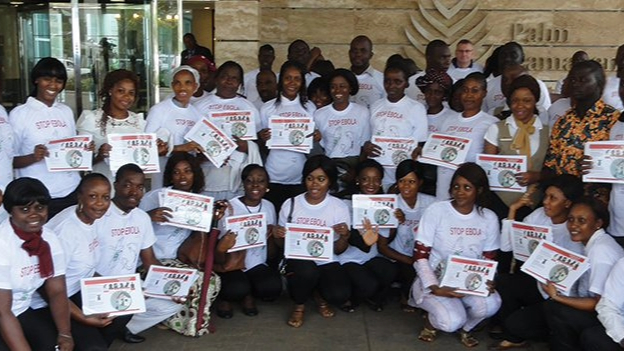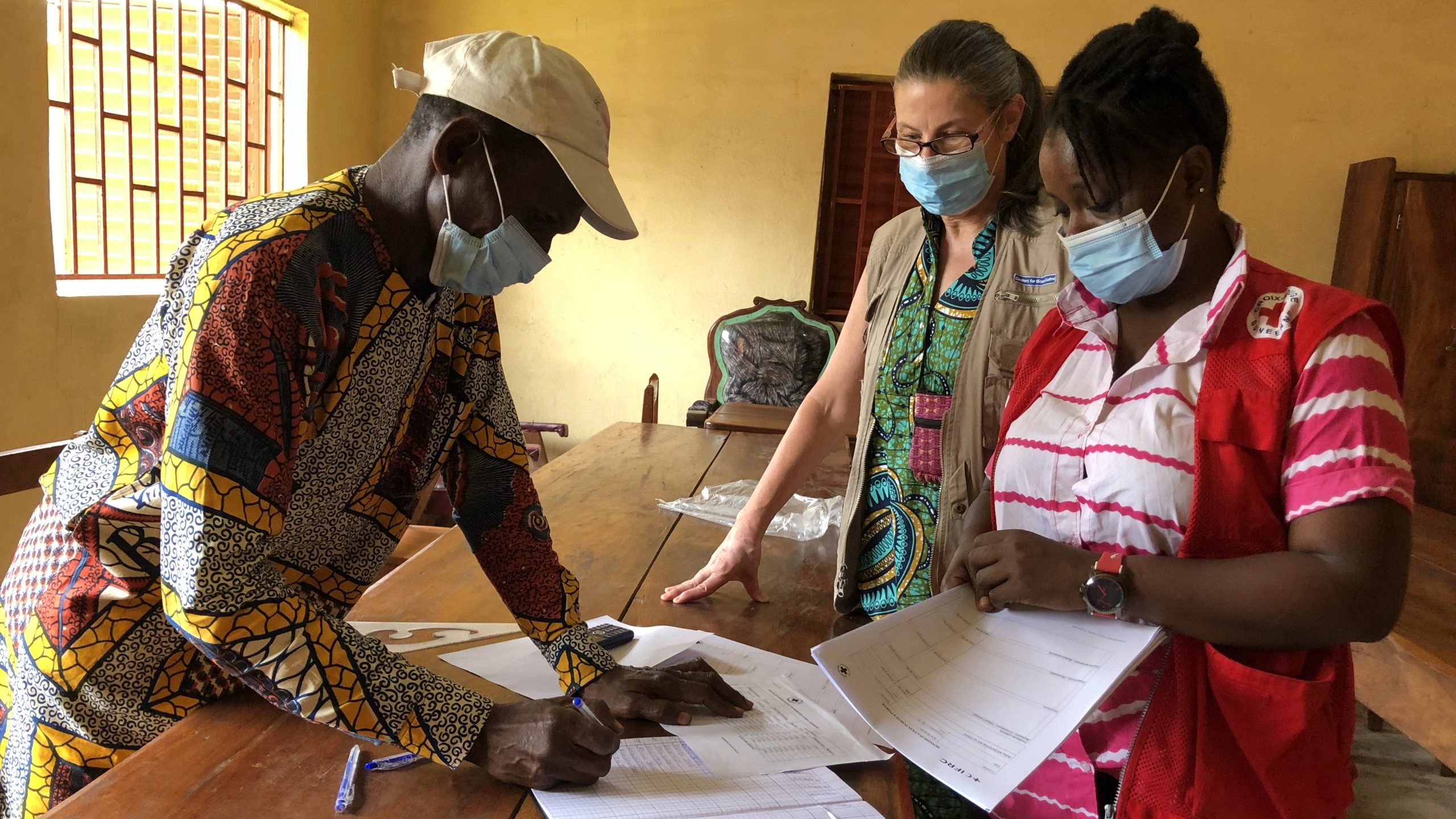At a glance
- With CDC's assistance, Guinea successfully contained the 2021 Ebola outbreak within four months, overcoming the danger of potential widespread transmission.
- CDC helped improve laboratory capacity, train field epidemiologists, upgrade surveillance systems, and establish an Emergency Operations Center.
- These efforts underscore the importance of continued investment in global health security to protect Guinea and the world from future disease emergencies.
Strengthening Guinea’s Ability to Effectively Handle Ebola Outbreaks

The capacity Guinea has to stop public health emergencies has come a long way since it faced the West Africa Ebola epidemic of 2014–2016. Collaboration and support from the U.S. Centers for Disease Control and Prevention (CDC) and partners in Guinea helped to end a recent Ebola outbreak in just four months.
In 2021, an outbreak that started in February resulted in 23 cases and 12 deaths in N'Zérékoré Prefecture in Guinea, the only region affected. The public health system had the necessary resources, including laboratory capacity, public health workforce, and surveillance and emergency response systems for a coordinated response. In contrast during the 2014–2016 outbreak more than 3,800 people became infected and over 2,500 people died in Guinea. Ebola spread to 10 countries worldwide, including the United States. Outdated public health infrastructure in Guinea during that time contributed to a delay in disease detection and widespread death.
Ebola Response in:
2014
2021
Laboratory
- Limited in-country laboratory capacity for diagnostic testing
- Results took about 7 days
- Local laboratories capable of testing
- Results take about 1 day
Workforce Development
- International experts and staff needed for response
- Guinea has 179 disease detectives trained for outbreak response
Surveillance
- Four months to detect first case
- Data collected in Excel
- 15 days to detect first case
- All surveillance data collected by Ministry of Health in the country’s DHIS2 electronic platform
Emergency Operations
- International partners managed improvised Emergency Operations Center (EOC)
- National EOC network activated within 24 hours of an alert. EOC is centrally coordinated under Agence Nationale de Sécurité Sanitaire (ANSS)
Coordination
- Disjointed response
- Unified response coordinated under ANSS leadership using modern technology
The Impacts of Laboratory Investments in Guinea
The 2014–2016 Ebola epidemic highlighted the need for strengthened global health security in Guinea for a safer and healthier world. CDC opened an office in Guinea in 2015 to help prepare the country for disease response, strengthen laboratory infrastructure, and strengthen workforce capacity. Early in the 2014–2016 Ebola epidemic, the ability to test for Ebola in-country was limited and could require up to seven days to confirm a diagnosis. CDC helped improve testing ability and worked with partners to train laboratory staff and build capacity. In 2016, the U.S. Department of Defense donated a laboratory to the Ministry of Health (MoH) that contributed to the overall in-country capacity for Ebola diagnostic testing in Guinea. The laboratory was used to support the 2021 Ebola outbreak and COVID-19 diagnostic testing. CDC also supported the development of regional laboratories in the cities of Kankan and Labe.
The Impacts of Disease Detection and FETP Workforce in Guinea
One of the most impactful ways for improving disease surveillance is trained field epidemiologists, or disease detectives. In 2016, CDC launched the Guinea Field Epidemiology Training Program (FETP) with funding from Global Health Security Agenda (GHSA). Since its inception, Guinea's FETP has trained nearly 200 disease detectives, many of whom held key surveillance and response positions during the 2021 Ebola outbreak. During the 2014–2016 Ebola epidemic, it took nearly four months to identify the first case while the disease spread. In 2021, trained FETP disease detectives responded to the first Ebola case and helped contain the spread of the disease. These epidemiologists helped quickly isolate suspect cases and identify contacts to help keep others from becoming sick.
The Impacts of Surveillance Upgrades
In 2020, Guinea's National Public Health Institute, Agence Nationale de Sécurité Sanitaire (ANSS), with assistance from the African Field Epidemiology Network (AFENET), used the District Health Information Software (DHIS2) to develop a case-based module to manage the response to the COVID-19 pandemic. ANSS created a similar module for the 2021 Ebola outbreak. This module captures information on cases, contacts, and alerts, and will be enhanced with future outbreaks. CDC helps develop and implement these systems with funding and technical assistance, including building capacity at the national and sub-national levels. These upgrades facilitated the prompt identification of Ebola in 2021 in only 15 days, compared to four months during the country's earlier outbreak.
In Guinea, data collection has advanced from an Excel database used during the 2014–2016 epidemic, to a modern disease surveillance system. In 2016, the country started implementation of an electronic surveillance data collection system through DHIS2. CDC deployed experts to aid with enhancements to Guinea's DHIS2 Ebola tracking system. They also supported data analysis and reporting that helped improve data quality and timeliness. Guinea's ANSS uses DHIS2 to capture and report aggregate data for epidemic-prone diseases to inform response.
The Value of Emergency Operations Centers and a Coordinated Response

During the 2014–2016 Ebola epidemic, Guinea did not have a national Emergency Operations Center (EOC) network. CDC provided staff and financial support to activate an improvised EOC. Members of Guinea's MoH also received CDC emergency management training. Now ANSS operates as a centralized coordinating agency to manage outbreaks. CDC, with GHSA funding, developed 38 district-level EOCs that collaborate under ANSS. By 2021, Guinea's EOC network had the capacity to simultaneously coordinate responses to five diseases—polio, measles, yellow fever, COVID-19, and Ebola—and activate within 24 hours of each emergency declaration.
CDC's GHSA investments in Guinea in four essential areas—laboratory, workforce development, surveillance, and emergency preparedness and response—played a key role in the country detecting and responding to the 2021 Ebola outbreak.
These successes do not mean that the work is over. CDC's continued investments ensure that Guinea is ready to address future disease emergencies and protect the health of people there and around the world.